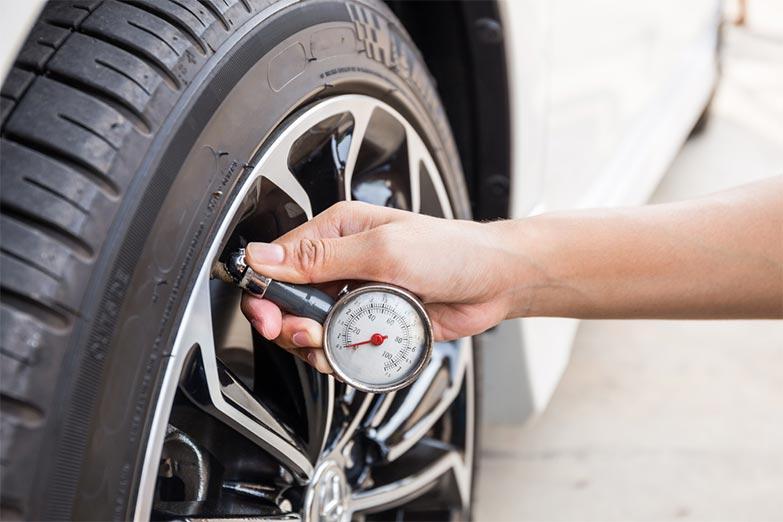Maintaining the proper tire pressure is a safety issue and related to the premature tire wear. It is one of the most ignored general maintenance issues. Most drivers don’t become aware of the ideal tire pressure until the tire shows any visible damage or the car suffers any consequence.
What should you tire pressure be and what are the signs of underinflated tires? Why should you regularly check tires pressure for car to drive smoothly?
Contents
Why Does Proper Tire Pressure Matter?
You should maintain the best tire pressure – neither over-inflating nor under-inflating. Both conditions affect fuel economy and cause safety concerns.
When a tire is underinflated, a minimum amount of its rubber stays in contact with the pavement. As a result, the rim can break away if you continue driving without correcting the pressure. According to the National Highway Traffic Safety Administration, underinflated tires increase the risks of car crashes by three times.
Overinflated tires are also susceptible to damage when you drive the car over potholes or debris. They lead to the deterioration of inner tread and center tread. The wear affects traction and decreases the tire’s lifespan.

>> Find a suitable Japan cheap used car for yourself? Click here <<
The benefits of having the right car tire pressure are:
- Increased lifespan
- Better gas mileage
- Smooth driving experience
- Less risk of car accidents
How Much Air Should I Pump Up My Tires?
What is normal tire pressure? Is there any recommended tire pressure chart? Well, determining the proper tire pressure depends on a couple of factors including the type of the car and tires, the kind of roads you usually drive on, the intended use of the car, and more.
How much psi in tires should you put? The regular ones require something between 32 and 35 psi (pounds per square inch) of air. It can go up to 50 to 60 psi for larger tires. The numbers are likely to be even higher for tires in a heavy-duty vehicle.
The recommended numbers refer to the minimum amount of air pressure required for the car to maintain its maximum load-carrying capacity. Lower psi than the number means trouble including premature tread wear, lower fuel efficiency, excessive flexing, and poor handling.
However, there is a wide range of vehicles you seen on the roads these days. The range of proper tire pressure for these cars varies by a bigger margin than in previous years. It’s also not rare to find some models that have separate pressure ratings for the front and rear tires.
Regarding the tire pressure, always follow the manufacturer’s recommendation. You will find the number in the owner’s manual, on the fuel door, on the lid of the trunk, or on a sticker in the door jam.
What Is the Maximum Limit for Car Tire Pressure?
The sidewall of the tire is the best place to look for the max tire pressure. It is likely to be below the manufacturer’s name. If it reads ‘Max. Press. 35 PSI’, it means that the maximum pressure it can carry is 35 psi. It is sometimes referred to as cold pressure, which means the air pressure when filling up cold tires. So, you should inflate the tires in the morning or after the car cools down for a few hours in the garage.
Can you inflate the tires to the maximum PSI? What will happen then?
Filling up the tires with the maximum tire pressure means the sidewall won’t expand much under any circumstance. You will get nice handling while making the corner. However, cornering with a high speed can be dangerous as it can make the car to slide.
Also, it decreases the expected lifetime of the tires. The center deteriorates pretty fast because of the rubber rounding out at the top of the tire. Over-inflation may also result in reduced traction and a blowout.
How to Detect an Underinflated Tire?
Despite maintaining a proper tire pressure, there could be times when the tires have less than the recommended psi. Under-inflation is more common than over-inflation because a tire can leak air for many reasons.
It is tough to detect the under-inflation unless you are stranded somewhere with a flat tire. However, there are still some signs that will help you to spot the problem. Of course, you can carry a gauge to measure the pressure whenever you want but that is not very convenient.

SEE MORE :
The handling of your car will feel a bit off. It won’t run smoothly and braking may take longer than usual.
A shaking steering wheel also indicates that the car does not have a proper tire pressure. Under-inflation leads to misalignment of the wheels, resulting in a rough driving experience with vibration in several parts of the vehicle.
An under-inflated tire tends to wear at a quicker rate. If you can detect that the tread of the tires is deteriorating faster than usual, check the tire pressure. You can also look for cracks on the tire’s surface.




I do appreciate the information. It is very educative. Thanks a lot for this .
Michael